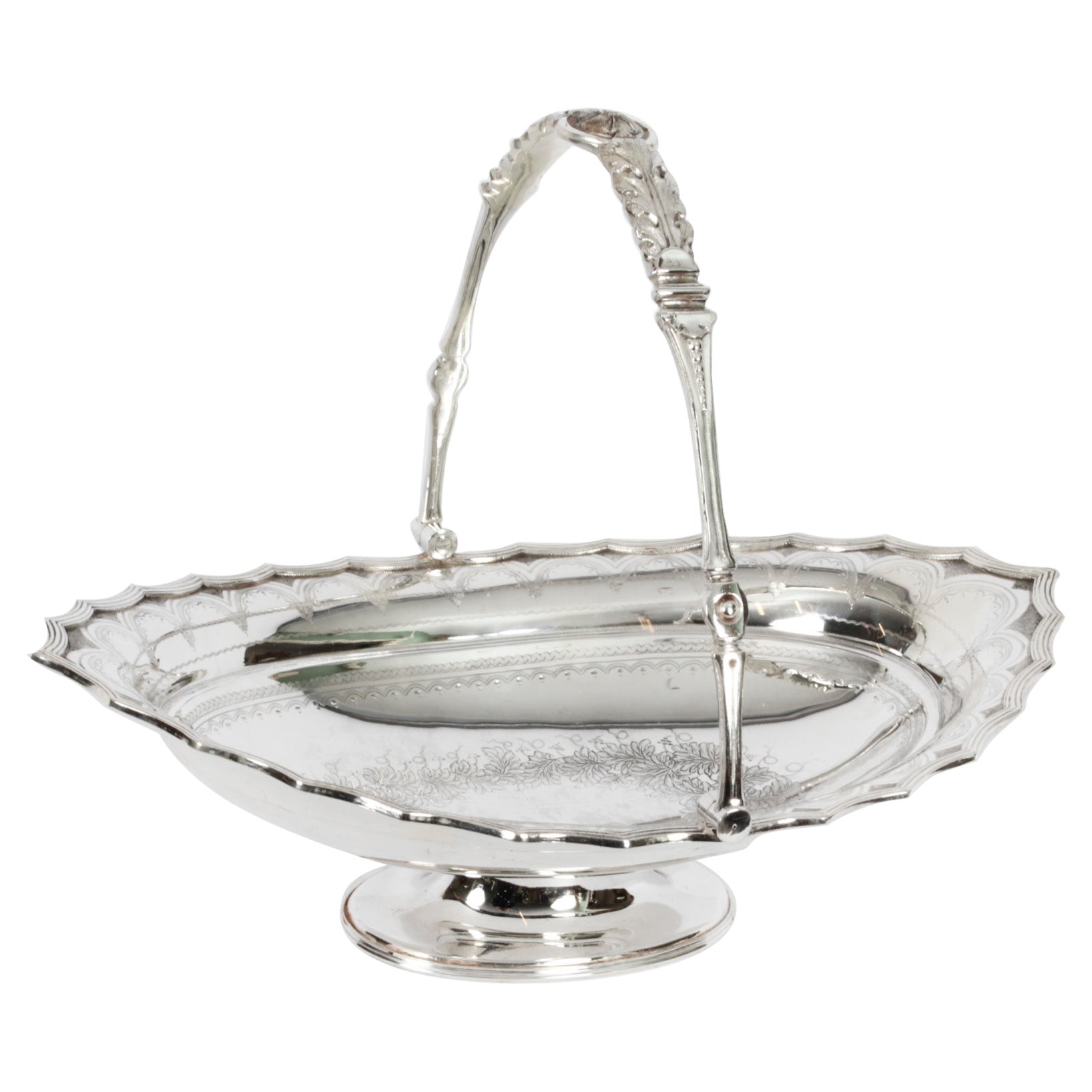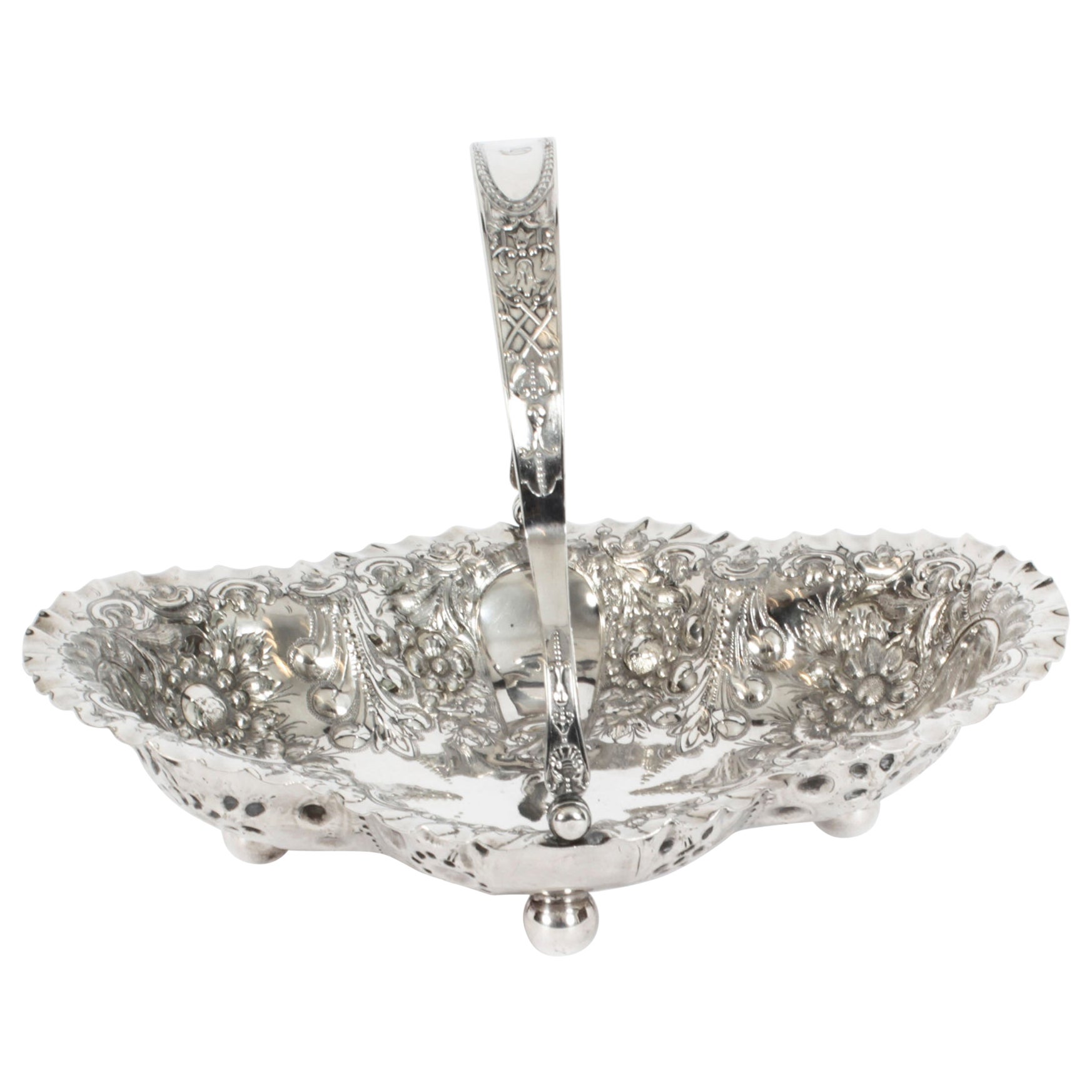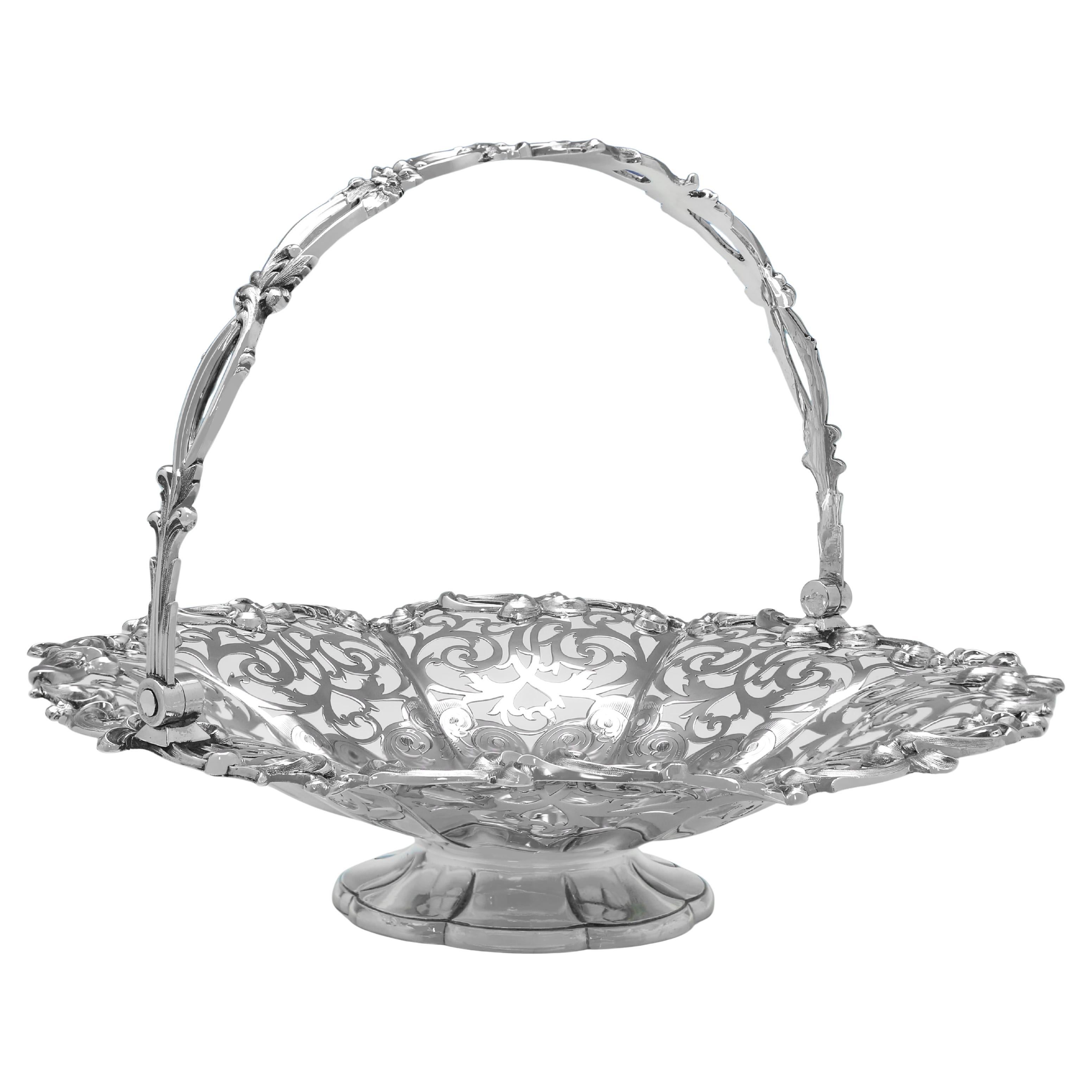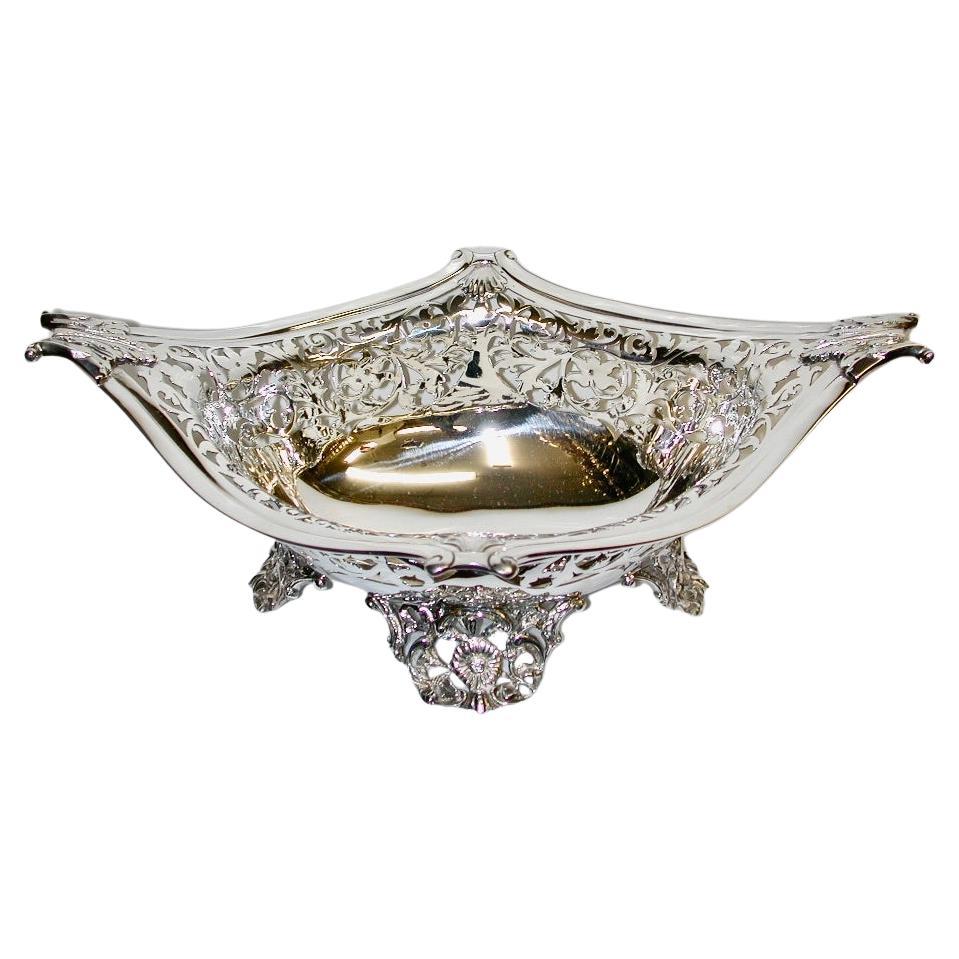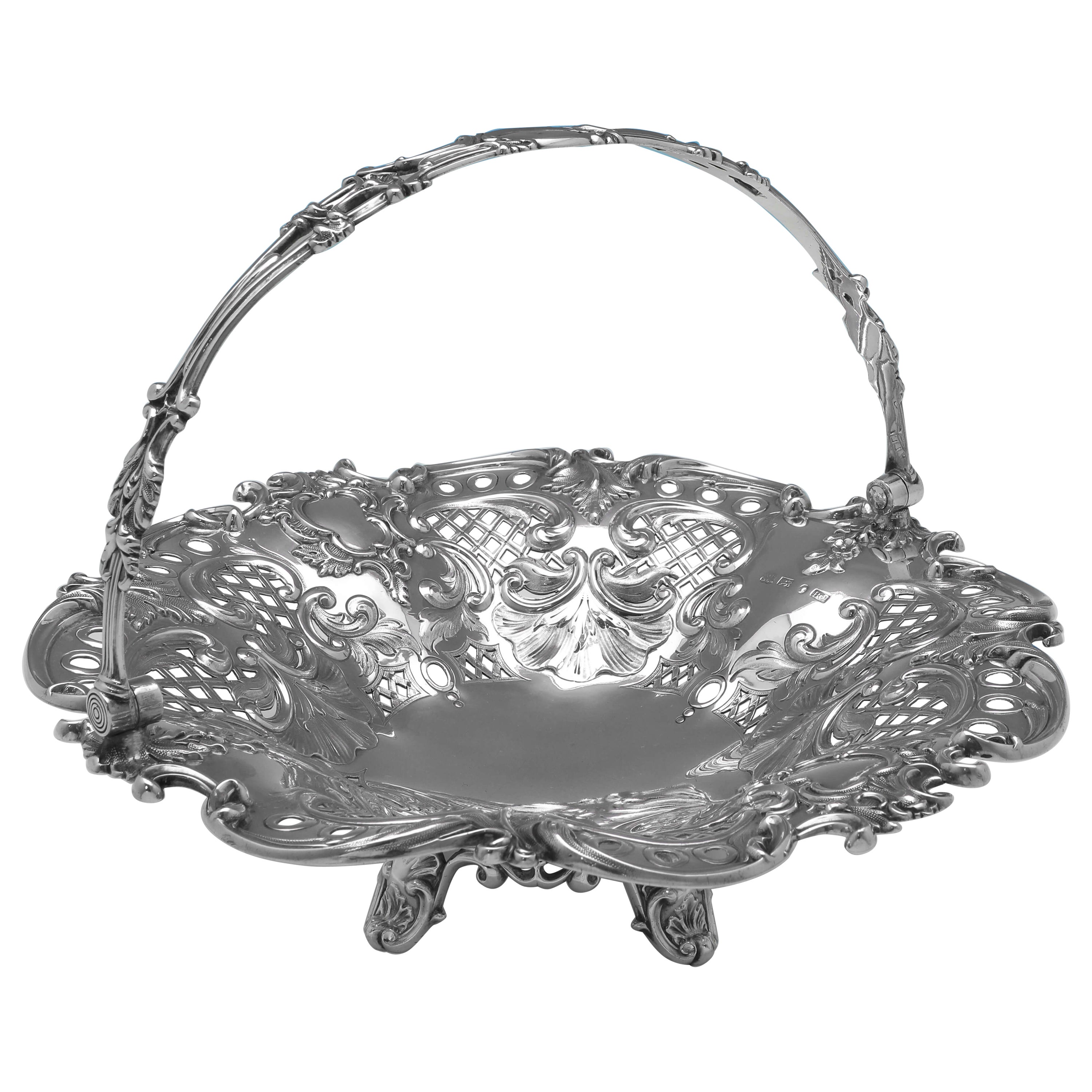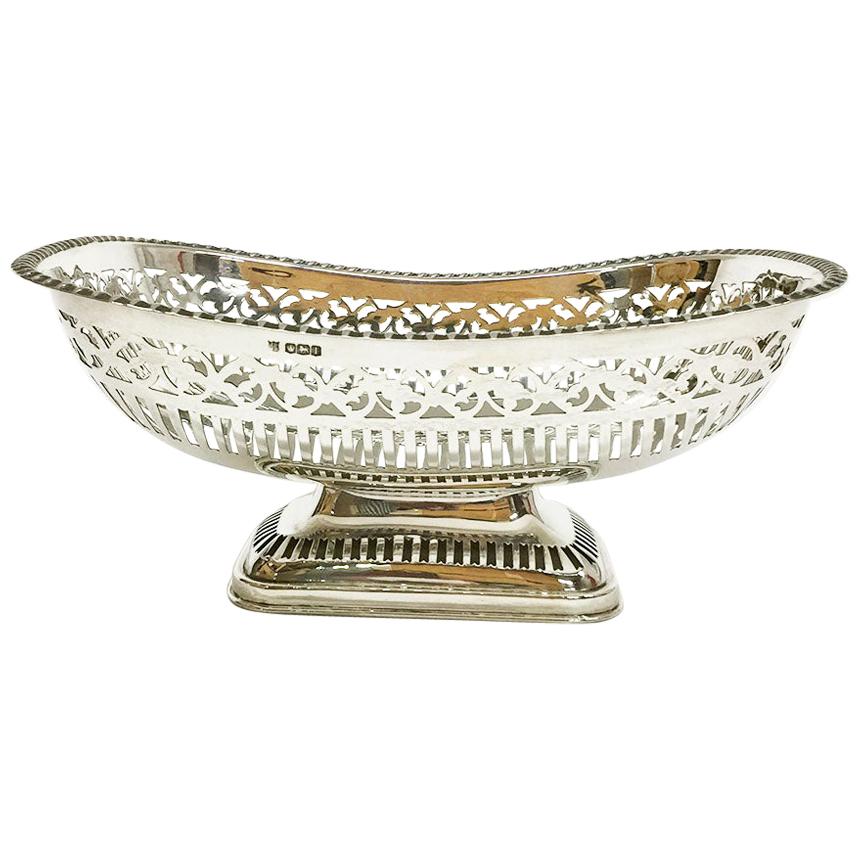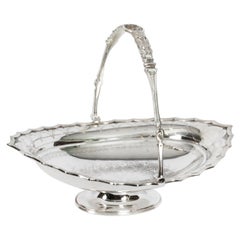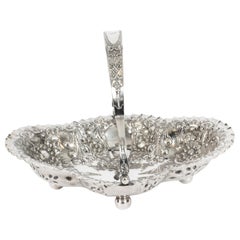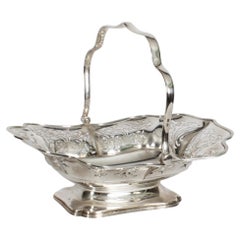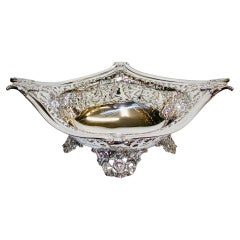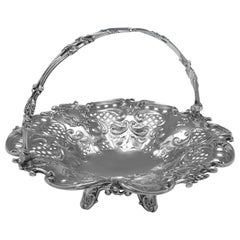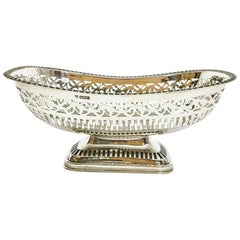Articoli simili a Antique Old Sheffield Plated Fruit Basket by Matthew Boulton 19th Century
Caricamento del video
Vuoi altre immagini o video?
Richiedi altre immagini o video al venditore
1 di 16
Antique Old Sheffield Plated Fruit Basket by Matthew Boulton 19th Century
450,49 €
Informazioni sull’articolo
This is a stunning George III Old Sheffield Plate swing handled cake/fruit basket bearing the sunburst makers marks of the world renowned silversmith Matthew Boulton, circa 1820 in date.
The basket features a swing handle, is chased and engraved with flowers, scrolling stiff leaves and fruiting vine and has a wonderful engraved coat of arms in the centre.
The attention to detail is absolutely fantastic and it is certain to attract attention wherever it is placed.
Condition:
In excellent condition with clear makers marks and no dings, dents or signs of repair. Please see photos for confirmation.
Dimensions in cm:
Height 24 cm x Width 30 cm x Depth 30 cm
Dimensions in inches:
Height 9 inches x Width 1 foot x Depth 1 foot
Matthew Boulton
Boulton was not a "goldsmith" or a "silversmith" in the accepted sense, yet for his achievements and services to the craft of goldsmithing he is fully worthy of inclusion in the list of great English goldsmiths.
Matthew Boulton was born in Birmingham on 3 September 1728. His father Matthew Boulton (senior) was a "toy maker" and silver stamper specialized in the production of shoe-buckles.
Boulton junior was taken into partnership in 1749 and was left in sole charge of the business after the death of his father in 1759.
Boulton had the ambition to establish a manufacturing complex where craftsmen in the various branches of the "toy" trade would work together under one roof, enabling him to reap both wholesale and retail profits. In 1761 he realized his project purchasing a one-hundred- year-lease of the "Soho" estate at Handswoth Heath (two miles from Snow Hilton the Wolverhampton Road).
In 1762 Boulton took into unofficial partnership John Fothergill who would act as a travelling salesman to advertise his wares and the factory moved to Soho in the same year.
The partnership concentrated in the production of steel "toys" a little later on buttons and buckles made in a variety of substances, including , of course, silver. In 1762 Soho factory began to produce articles in "Sheffield" plate and one of the first to adopt "Sterling silver thread" edging which prevent to reveal the underlying copper.
Boulton soon became the largest manufacturer of "Sheffield plate" of the country expanding the business of Soho manufactory in the production of bijouterie, objects d'art and de virtue, in ormolu, pinchbeck and shell, and in clocks.
In 1765 Boulton began the manufacture of pieces in solid silver, being obliged to send every piece of plate to Chester to be marked (Chester was the nearest assay office, 72 miles away from Birmingham). Boulton was the promoter a petition obtaining in 1773 the Royal Assent to assay silver in Birmingham (the same was for Sheffield).
Boulton & Fothergill entered their joint mark consisting of their initials, MB before IF. After the death of Fothergill (1782) Boulton punched his plate with his initials alone.
When manufacturers of plated ware were permitted to register their marks at the Assay Office in Sheffield (1784), Boulton registered his mark of "twin suns" under the name Boulton M. & Co.
The most important designers for Boulton plate in the neo-classic taste were Robert Adams and James Wyatt.
Matthew Boulton died on 17 August 1809.
The mark MB continued to be used by Matthew Boulton Plate Co until 1832.
Old Sheffield Plate - or ‘fused plate’ as it is sometimes known, was the first commercially viable method of plating metal.
The material was accidentally invented by Thomas Boulsover, of Sheffield's Cutlers Company, in 1743. While trying to repair the handle of a customer's decorative knife, he heated it too much and the silver started to melt. When he examined the damaged handle, he noticed that the silver and copper had fused together very strongly. Experiments showed that the two metals behaved as one when he tried to reshape them, even though he could clearly see two different layers.
Boulsover set up in business, funded by Strelley Pegge of Beauchief, and carried out further experiments in which he put a thin sheet of silver on a thick ingot of copper and heated the two together to fuse them. When the composite block was hammered or rolled to make it thinner, the two metals were reduced in thickness at similar rates. Using this method, Boulsover was able to make sheets of metal which had a thin layer of silver on the top surface and a thick layer of copper underneath. When this new material was used to make buttons, they looked and behaved like silver buttons but were a fraction of the cost.
The technique Boulsover developed was to sandwich an ingot of copper between two plates of silver, tightly bind it with wire, heat it in a furnace and then mill it out in to sheet, from which objects could be made.
Our reference: A4520
- Dimensioni:Altezza: 24 cm (9,45 in)Larghezza: 30 cm (11,82 in)Profondità: 30 cm (11,82 in)
- Stile:Giorgio III (Nello stile di)
- Materiali e tecniche:
- Luogo di origine:
- Periodo:
- Data di produzione:circa 1820
- Condizioni:
- Località del venditore:London, GB
- Numero di riferimento:Venditore: A45201stDibs: LU950645390982
Informazioni sul venditore
5,0
Venditore Platino
Venditori Premium con valutazione 4.7+ e tempi di risposta entro 24 ore
Fondazione nel 1983
Venditore 1stDibs dal 2012
1377 vendite su 1stDibs
Tempo di risposta standard: <1 ora
Associazioni
LAPADA - The Association of Arts & Antiques Dealers
- SpedizioneRecupero del preventivo…Spedizione da: London, Regno Unito
- Politica di reso
Alcune parti di questa pagina sono state tradotte automaticamente. 1stDibs non può garantire che le traduzioni siano corrette. L’inglese è la lingua predefinita del sito.
Garanzia di autenticità
Nell’improbabile caso in cui si verifichi un problema con l’autenticità di un articolo, contattaci entro un anno per ottenere un rimborso completo. DettagliGaranzia di rimborso
Se il tuo articolo non corrisponde alla descrizione, è danneggiato durante il trasporto o non arriva, contattaci entro 7 giorni per un rimborso completo. DettagliAnnullamento entro 24 ore
Hai un periodo di tolleranza di 24 ore per annullare il tuo acquisto, senza necessità di fornire spiegazioni.Venditori professionali selezionati
I nostri venditori di livello internazionale devono aderire a rigorosi standard di servizio e qualità, garantendo l’integrità delle inserzioni.Garanzia miglior prezzo
Se scopri che un venditore ha pubblicato altrove lo stesso articolo a un prezzo più basso, applicheremo lo stesso prezzo.Consegna globale affidabile
La nostra rete di vettori leader del settore offre opzioni di spedizione specializzate in tutto il mondo, inclusa la consegna personalizzata.Altro da questo venditore
Mostra tuttoAntico cesto di frutta vittoriano placcato in argento del XIX secolo
Si tratta di uno splendido cesto di frutta antico vittoriano placcato in argento, datato circa 1860.
Il corpo di forma ovale presenta una favolosa decorazione fogliare incisa...
...
Categoria
Di antiquariato/d’epoca, Anni 1860, Inglese, Vittoriano, Accessori Sheff...
Materiali
Placcato argento
Antico cesto di frutta vittoriano placcato in argento James Dixon XIX secolo
Di James Dixon & Sons
Si tratta di un cesto di frutta d'epoca vittoriana inglese eccezionalmente bello e placcato in argento con marchio del celebre argentiere James Dixon, datato circa 1880.
Questo m...
Categoria
Di antiquariato/d’epoca, Anni 1880, Inglese, Vittoriano, Accessori Sheff...
Materiali
Placcato argento
Antico inglese Edward VII Cestino per pane e frutta in argento Sterling Sheffield, 1907
Di Atkin Brothers
Si tratta di un cesto di frutta in argento sterling inglese edoardiano eccezionalmente bello, con marchi di Sheffield 1907 e il marchio di Atkin Brothers.
Questo magnifico cesto h...
Categoria
Di antiquariato/d’epoca, Inizio Novecento, Inglese, Edoardiano, Accessor...
Materiali
Placcato argento
Antico cesto in argento e rame di George III Old Sheffield del XIX secolo
Si tratta di un favoloso cestino per il pane e il piatto da frutta in rame di epoca neoclassica George III Old Sheffield, datato circa 1810.
Il cesto rettangolare con manico oscilla...
Categoria
Di antiquariato/d’epoca, XIX secolo, Inglese, Neoclassico, Articoli per ...
Materiali
Placcato argento, Rame
Antico cesto in argento e rame di Giorgio III Old Sheffield, 18° secolo
Si tratta di un favoloso cestino per il pane e il piatto da frutta in rame di epoca neoclassica George III Old Sheffield, datato circa 1780.
Il piatto ovale con manico oscillante...
Categoria
Di antiquariato/d’epoca, Anni 1780, Inglese, Giorgio III, Accessori Shef...
Materiali
Sheffield
Antica zuppiera di piatti di Sheffield e coperchio a cupola, 18° secolo
Si tratta di una magnifica grande zuppiera d'argento inglese Old Sheffield con il coperchio a cupola originale, datata circa 1790.
Porta il marchio a croce di I. E sta per John Edwa...
Categoria
Di antiquariato/d’epoca, Anni 1790, Inglese, Accessori Sheffield e placc...
Materiali
Sheffield
Ti potrebbe interessare anche
Cestino da frutta in argento sterling del XIX secolo realizzato a Londra nel 1853
Di James & Nathaniel Creswick
Marchiato a Londra nel 1853 da James & Nathaniel Creswick, questo attraente cestino vittoriano in argento antico presenta un bordo fuso, decorazioni traforate e incise sul corpo e un...
Categoria
Di antiquariato/d’epoca, Anni 1850, Inglese, Vittoriano, Ceste decorative
Materiali
Argento 925
Antico cesto di frutta d'argento vittoriano datato 1898 Londra William Hutton & Sons
Di William Hutton & Sons
Antico cesto di frutta d'argento vittoriano datato 1898 London William Hutton & Sons Ltd
Un favoloso cesto che può essere utilizzato per tante altre cose oltre alla frutta, ad esempi...
Categoria
Di antiquariato/d’epoca, Anni 1890, Inglese, Vittoriano, Argento 925
Materiali
Argento 925
Cesto antico vittoriano in argento sterling - Sheffield 1845 - Hawksworth Eyres
Marchiato a Sheffield nel 1845 da Hawksworth Eyres & Co., questo attraente cestino antico in argento sterling ha un design ornato, poggia su piedi in conchiglia e presenta decorazion...
Categoria
Di antiquariato/d’epoca, Anni 1840, Inglese, Vittoriano, Argento 925
Materiali
Argento 925
Cestino da frutta inglese in argento sterling di James Deakin & Sons, 1928
Di James Deakin & Sons
Cestino da frutta in argento sterling inglese di James Deakin & Sons, 1928
Cestino da frutta rettangolare inglese in argento sollevato su una base.
Un cestino in argento sterling d...
Categoria
Inizio XX secolo, Britannico, Argento 925
Materiali
Argento
L & WS English Victorian Silver Plated Footed Fruit Bread Basket with Handle (Cestino da pane con piedini)
Antico cestino da pane con piedini in argento placcato d'argento di I.L.A. con manico. Circa metà del XX secolo.
Misure: 3,5" H. x 12" W. x 9,5" D.
Categoria
Metà XX secolo, Vittoriano, Ciotole decorative
Materiali
Placcato argento
Cestino per torte in argento Melvin Pratt di epoca vittoriana di fine Ottocento con manico
Cestino da torta rotondo in argento Melvin Pratt di epoca vittoriana, risalente alla fine del XIX secolo, con design traforato e motivi a fogliame. Creato in Inghilterra da Melvin Pr...
Categoria
Di antiquariato/d’epoca, XIX secolo, Inglese, Vittoriano, Accessori Shef...
Materiali
Argento
